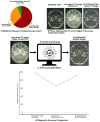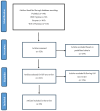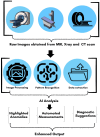AI-Driven Advances in Low-Dose Imaging and Enhancement-A Review
- PMID: 40150031
- PMCID: PMC11941271
- DOI: 10.3390/diagnostics15060689
AI-Driven Advances in Low-Dose Imaging and Enhancement-A Review
Abstract
The widespread use of medical imaging techniques such as X-rays and computed tomography (CT) has raised significant concerns regarding ionizing radiation exposure, particularly among vulnerable populations requiring frequent imaging. Achieving a balance between high-quality diagnostic imaging and minimizing radiation exposure remains a fundamental challenge in radiology. Artificial intelligence (AI) has emerged as a transformative solution, enabling low-dose imaging protocols that enhance image quality while significantly reducing radiation doses. This review explores the role of AI-assisted low-dose imaging, particularly in CT, X-ray, and magnetic resonance imaging (MRI), highlighting advancements in deep learning models, convolutional neural networks (CNNs), and other AI-based approaches. These technologies have demonstrated substantial improvements in noise reduction, artifact removal, and real-time optimization of imaging parameters, thereby enhancing diagnostic accuracy while mitigating radiation risks. Additionally, AI has contributed to improved radiology workflow efficiency and cost reduction by minimizing the need for repeat scans. The review also discusses emerging directions in AI-driven medical imaging, including hybrid AI systems that integrate post-processing with real-time data acquisition, personalized imaging protocols tailored to patient characteristics, and the expansion of AI applications to fluoroscopy and positron emission tomography (PET). However, challenges such as model generalizability, regulatory constraints, ethical considerations, and computational requirements must be addressed to facilitate broader clinical adoption. AI-driven low-dose imaging has the potential to revolutionize radiology by enhancing patient safety, optimizing imaging quality, and improving healthcare efficiency, paving the way for a more advanced and sustainable future in medical imaging.
Keywords: CT scans; artificial intelligence; deep learning; low-dose imaging; radiation safety; radiology.
Conflict of interest statement
The authors declare no conflicts of interest.
Figures





Similar articles
-
AI for image quality and patient safety in CT and MRI.Eur Radiol Exp. 2025 Feb 23;9(1):28. doi: 10.1186/s41747-025-00562-5. Eur Radiol Exp. 2025. PMID: 39987533 Free PMC article. Review.
-
Transforming Medical Imaging: The Role of Artificial Intelligence Integration in PACS for Enhanced Diagnostic Accuracy and Workflow Efficiency.Curr Med Imaging. 2025 Apr 22. doi: 10.2174/0115734056370620250403030638. Online ahead of print. Curr Med Imaging. 2025. PMID: 40265427
-
Integrating artificial intelligence with endoscopic ultrasound in the early detection of bilio-pancreatic lesions: Current advances and future prospects.Best Pract Res Clin Gastroenterol. 2025 Feb;74:101975. doi: 10.1016/j.bpg.2025.101975. Epub 2025 Jan 4. Best Pract Res Clin Gastroenterol. 2025. PMID: 40210329 Review.
-
Revolutionizing Radiology With Artificial Intelligence.Cureus. 2024 Oct 29;16(10):e72646. doi: 10.7759/cureus.72646. eCollection 2024 Oct. Cureus. 2024. PMID: 39474591 Free PMC article. Review.
-
Artificial intelligence for breast cancer detection and its health technology assessment: A scoping review.Comput Biol Med. 2025 Jan;184:109391. doi: 10.1016/j.compbiomed.2024.109391. Epub 2024 Nov 22. Comput Biol Med. 2025. PMID: 39579663
Cited by
-
Emerging Imaging Technologies in Forensic Medicine: A Systematic Review of Innovations, Ethical Challenges, and Future Directions.Diagnostics (Basel). 2025 Jun 1;15(11):1410. doi: 10.3390/diagnostics15111410. Diagnostics (Basel). 2025. PMID: 40506982 Free PMC article. Review.
-
Reversing Epigenetic Dysregulation in Neurodegenerative Diseases: Mechanistic and Therapeutic Considerations.Int J Mol Sci. 2025 May 21;26(10):4929. doi: 10.3390/ijms26104929. Int J Mol Sci. 2025. PMID: 40430067 Free PMC article. Review.
-
Evolving and Novel Applications of Artificial Intelligence in Cancer Imaging.Cancers (Basel). 2025 Apr 30;17(9):1510. doi: 10.3390/cancers17091510. Cancers (Basel). 2025. PMID: 40361437 Free PMC article. Review.
-
New insights on femoral head trabecular bone directionality in elderly humans using a micro-CT-based analysis.Sci Rep. 2025 Jul 7;15(1):24228. doi: 10.1038/s41598-025-05991-1. Sci Rep. 2025. PMID: 40624103 Free PMC article.
References
-
- Abhisheka B., Biswas S.K., Purkayastha B., Das D., Escargueil A. Recent trend in medical imaging modalities and their applications in disease diagnosis: A review. Multimed. Tools Appl. 2024;83:43035–43070. doi: 10.1007/s11042-023-17326-1. - DOI
-
- Kissane J., Neutze J.A., Singh H., editors. Radiology Fundamentals: Introduction to Imaging & Technology. Springer Nature; Berlin Germany: 2020.
-
- Islam S.M.S., Nasim M.A.A., Hossain I., Ullah D.M.A., Gupta D.K.D., Bhuiyan M.M.H. Data-Driven Approaches on Medical Imaging. Springer Nature; Cham, Switzerland: 2023. Introduction of medical imaging modalities; pp. 1–25.
Publication types
LinkOut - more resources
Full Text Sources

